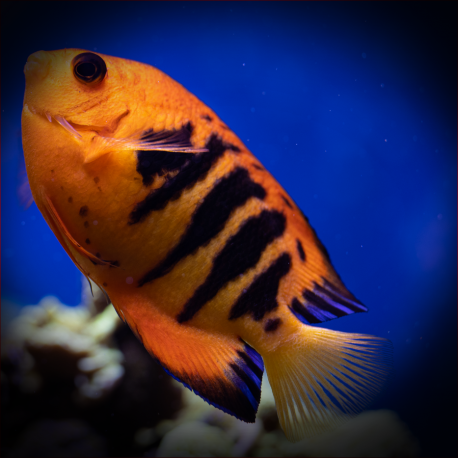More info
Datasheet
| Minimum Tank Size | 264 litres / 69.74 US gallons |
| Maximum Size | 10.2cm / 4.02inches |
| Reef Compatible | With Caution |
| Temperament | Semi-aggressive |
| Care Description | Moderate |
| Specific Gravity | 1.020-1.025 |
| Carbonate Hardness | 8-12 |
| pH | 8.1-8.4 |
General Description
The Flame Angelfish (Centropyge loricula) is a striking dwarf angelfish known for its bold red/orange coloration with vertical black stripes highlighting the body and horizontal black stripes on the blue-tipped dorsal and anal fins. It belongs to the Pomacanthidae family and can grow up to 10.2cm in size.
Aquarium Suitability
Suitable for aquariums, the Flame Angelfish requires a minimum tank size of 70 gallons with ample hiding spots and live rock for grazing. However, caution is advised as they tend to nip at stony and soft corals, sessile invertebrates, and clam mantles. Best added as the last fish in a peaceful community, they adapt well to aquarium life but are sensitive to elevated copper levels.
Care and Hardiness
Considered moderately demanding, the Flame Angelfish is semi-aggressive and should be housed with dissimilar genera. They prefer water conditions with a pH of 8.1-8.4, a specific gravity of 1.020-1.025, and a carbonate hardness (KH) of 8-12.
Reef Suitability
Reef compatibility with the Flame Angelfish is with caution due to their tendency to nip at corals and invertebrates. Careful consideration should be taken when introducing them to a reef tank.
Aquarium Setup
For the setup, ensure a well-established aquarium system with a variety of hiding spots and live rock for grazing. Maintaining stable water parameters is crucial, especially in regards to copper levels to ensure the health of the Flame Angelfish.
Behaviour
The Flame Angelfish can exhibit semi-aggressive behavior, particularly towards similar species or when establishing territory. Observing their interactions with tank mates is essential to prevent any aggressive encounters.
Feeding and Diet
As omnivores, the diet of the Flame Angelfish should include Spirulina, marine algae, high-quality angelfish preparations, mysis or frozen shrimp, and other meaty items. Providing a varied diet will help maintain their health and vibrant coloration.
Dimorphism
With no distinguishable differences in color between males and females, the Flame Angelfish is hermaphroditic and challenging to breed in captivity. Various geographical locations of collection can result in slight variations in color and markings among individuals, reflecting differences in pricing.

